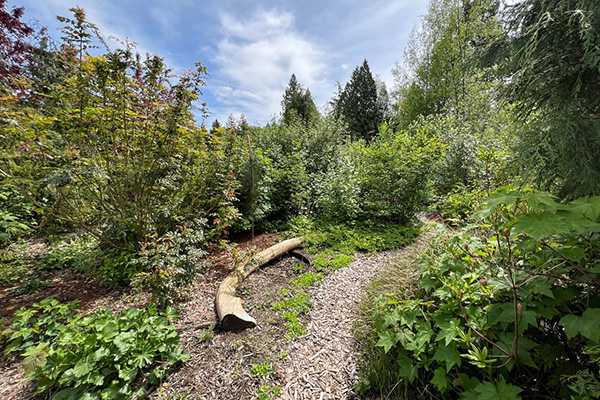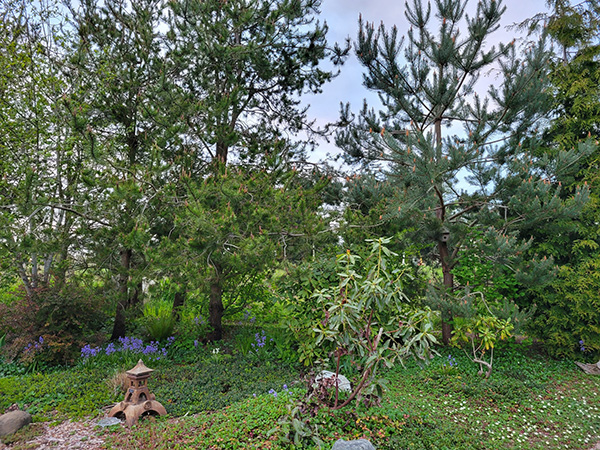Saturday, June 1, 2024 10 AM to 4 PM
Seven unique and beautiful Whatcom County native-plant focused gardens will open to the public, each owned and cultivated by amateur botanists and native plant enthusiasts, all WNPS Koma Kulshan chapter members. Distinctive among gardens, these will all showcase the beauty and practical advantages of plants that grow natively in the Pacific Northwest.
In our region’s relatively short horticultural history, our local native plants remain undiscovered wonders to most gardeners. Volunteers will be available to answer your questions, and learning materials will be available to help you bring native plant gardening to your home.
This is a free event but pre-registration is required and will open on Monday, May 20th. Please contact Eric Worden for more information (eric [at] ericworden.seattle.wa.us)
Learn more about gardening with native plants on the WNPS web site.
Details
- Event date and time: Saturday, June 1, 2024 10 AM to 4 PM. Please respect our hosts by limiting your visit to this date and time.
- This event is free and open to the public but pre-registration is required.
- Access the gardens’ addresses and other entry details will be available after pre-registration.
- Some garden areas are rough and uneven. Sturdy shoes are recommended.
- Sorry, no dogs allowed in the gardens except for service dogs.
Garden Descriptions
The seven gardens are listed here. You’ll get the addresses when you pre-register.
Dakota Creek Garden
This moderate-size native plant garden (approximately 1/6 acre) neighbors the Dakota Creek Kayak Launch parking lot in Blaine. It has been established in stages over the past 10 years, with rabbits being one of the greatest challenges during the process. Adjacent public lands have also been devoted to native plants. The landscape includes beautifully sculptured wood and stones designed to appear natural. Multiple habitats have been established within the garden, including a small forest, a wet area, a dry “mountain” area, and a meadow. Native plants were chosen to fit the soil type and sun exposure in different sections of the garden. A portion of the garden is now maturing with shore pines, red cedar, hemlock, and cascara. Understory shrubs and ground cover include strawberries, kinnikinick, evergreen huckleberry, and red-flowering currant. Hairy manzanita (challenging to grow) and leather leaf saxifrage are also thriving in the garden. All told, there are more than 60 native plant species in this native plant garden.
Heronswood Garden

Near Semiahmoo, this ambitious suburban garden on 0.6 acres, designed in the style of a young forest, and installed nine years ago, is now achieving glory. Where most suburban gardeners maintain a large manicured lawn between the street and the house, gardener Lyle Anderson created an idealized young forest. The moist and fertile site is divided by the driveway into sunnier and shadier sections, both with impressive diversity of species. The garden is dominated by shrubs and young trees—anchored by Alaskan Cedar, Western Larch, Garry Oak, and Black Hawthorn—with openings for tender understory plants to delight you as you meander the subtle paths within.
Paradise Acres

Located just north of the Bellingham airport, this 5-acre property has been gardened for more than 50 years by four sets of gardeners and currently cared for by Mark and Brian Turner. It’s framed on the east by an extensive native woodland border with masses of vine maples, red elderberries, thimbleberries, and salmonberries. Paths follow deer trails through 3 acres of woods carpeted with bleeding hearts, piggy-back-plant, fringecup, and nettles under red alders, a few mature conifers, and numerous young trees planted in the last seven years. There are seasonal wetlands and decaying stumps that tell the story of previous logging. The developed part of the garden features island beds with a mix of native and introduced plants. A pair of mostly-native beds out front, planted initially in 2015 and 2017, have a variety of native shrubs and perennials including four species of currants, hawthorn, serviceberry, red-twig dogwood, great camas, Cascade penstemon, and Scotch bluebells. Like most gardens, it’s a work in progress and not always impeccably manicured. Natives are also tucked into mixed perennial beds behind the house. You’ll also enjoy a rock garden with a mix of native dry-land species and a few non-native plants.
Agate Pond Preserve
More than a garden – this 100 acre property located on the east side of Squalicum Mountain is a true native plant preserve. Owner Tricia Otto has placed it under a conservation easement, permanently placing it under community protection as a wildlife refuge and balanced forest ecosystem. Since 1988, Tricia has worked to enhance native plant diversity and remove invasive species. Over 200 native species are growing here. Extensive wetlands are the primary feature, but the preserve also includes a second growth Douglas Fir forest and a one acre Midwest tall grass prairie in honor of Tricia’s mother, Lorrie Otto, and her conservation work in Wisconsin.
The wetlands, centered upon two naturalized ponds on Agate Creek, doubled in size to four acres a few years ago when a couple of beavers took up residence, dramatically changing the character of the wetlands. The wetland is best appreciated during late Spring and Summer.
Download: Agate Pond Preserve Plant List
Squalicum Garden
This country garden contains three sprawling acres of natural beauty. The landscape is a mixture of mature forest and vibrant wetlands that form a backdrop for garden landscaping that contains a diverse array of native and non-native ornamental plants that have been chosen for their beauty and enhancement of native habitats.
Yew Street Garden
In the forested area just east of Bellingham is this spacious and naturalistic woodland garden. Under the care of the same owners since the early 1990’s, this garden is elegant yet understated, and shows how the intrinsic beauty of nature may be allowed to unfold. Grassy and mossy open spaces are punctuated by vine maples that anchor islands of shady understory plants such as Solomon’s plume, Oregon oxalis, maidenhair ferns, and inside-out flower. Aged specimens of mock orange and serviceberry have grown to elegant stature. By embracing the shade of our natural forest environments, weeds are naturally suppressed, making this a low-maintenance, serene refuge.
Edgemoor Garden
This city garden was established gradually 10-15 years ago, replacing 3 patches of lawn one at a time according to a master plan. It mixes native plants with some exotics, with part of the garden being fully shaded. This Edgemoor garden features a carefully designed drip irrigation system which has become increasingly useful for hot, dry spells in summer.





